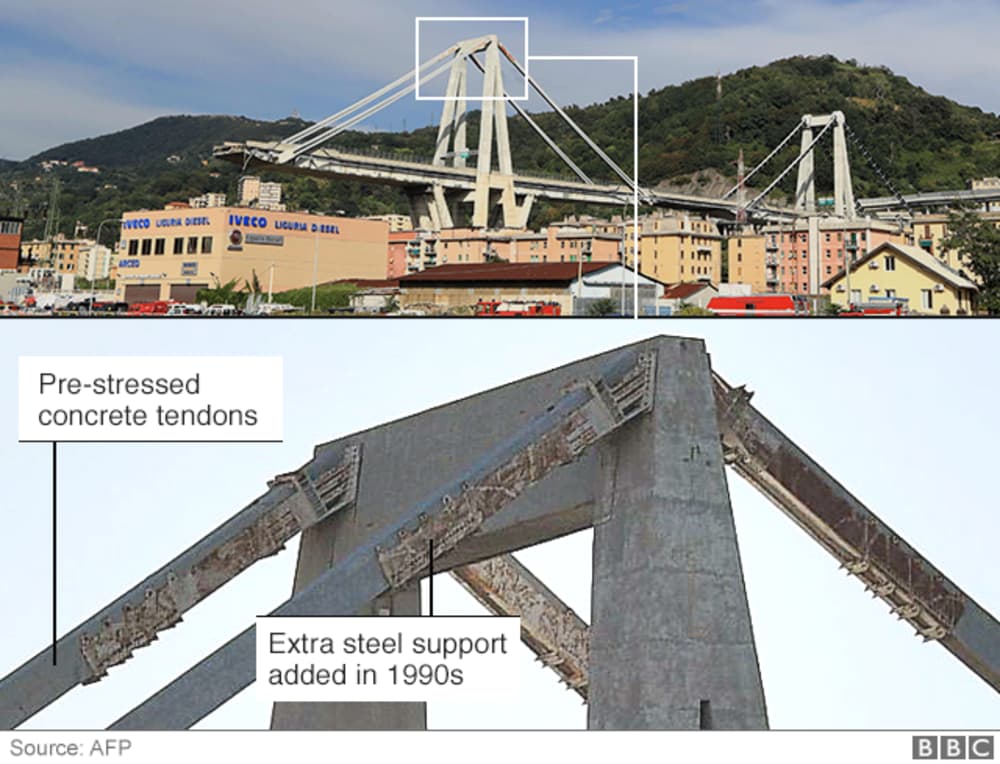Italy’s Morandi Bridge Collapse—What Do We Know?
https://www.engineering.com/BIM/ArticleID/17517/Italys-Morandi-Bridge-CollapseWhat-Do-We-Know.aspxAugust 22, 2018

...The main difference between the cable-stayed bridge and its close cousin, the suspension bridge, is that cable-stayed bridges lack the primary cables that connect towers to one another. They rely only on the cables that pass from tower to road.
Most cable-stayed bridges have multiple stays that fan out from the towers and attach to multiple points on the deck. This helps distribute the forces on the deck. Morandi’s bridge only had two stays per tower, one on each side.
The composition of these stays was unique. Most cable-stayed bridges have stays made of woven metal cables. Instead, Morandi used prestressed concrete around tie-rods, making it impossible to see the condition of the metal underneath....
...Covering the reinforcing metal with concrete would, of course, make it impossible to see the condition of the metal reinforcements. Indeed, an investigation into the bridge in 2017 was unable to determine if the reinforcement had corroded....
...“The original idea seems to have been to precompose the stralli [stays],†Bercich said. “[The] idea is clearly debatable because the stralli are structural elements too slender and allow a very modest pre-compression and, therefore, inevitably destined to have little effectiveness†(translated from Italian)
To support his point, he brought up the fact that the bridge and its sister bridge in Venezuela needed to have additional stays added to support the deck. The Venezuela bridge had a cable snap after corrosion weakened it.
When the Morandi Bridge was built, encasing a cable in concrete was innovative. However, because of all of these flaws, there are few bridges that use this type of construction....
...The Morandi Bridge was part of a privately owned toll highway system looked after by construction and maintenance company Autostrade per l’Italia. In the wake of the collapse, there have been questions about exactly how frequently, and thoroughly, maintenance was performed.
According to Autostrade, the company has spent over a billion euros ($1.15 billion) maintaining and improving its highways over the past five years. The Morandi has been a particularly costly investment. It’s been under almost-constant restoration since the 1970s. As early as 1979, Morandi wrote a report that recommended constant maintenance of the bridge to fill in exposed pieces of reinforcement and remove rust. Morandi blamed the bridge’s fragile state on a “well-known loss of superficial chemical resistance of the concrete†caused by sea air and airborne pollution from a nearby steel plant.
The bridge continued to need extensive maintenance throughout the 90s the 2000s and into the 2010s. In his 2016 report, Bercich called the bridge a “failure of engineering†and said that the costs of maintenance would soon outstrip the costs of building a new bridge....

...In February, technicians from both the transport ministry and company met to discuss the state of the bridge. According to a report published by Italian paper L’Espresso, they discussed the possibility that the bridge’s reinforced concrete stays might be degrading. “The designer has cautiously estimated a degree of average deterioration ranging from 10 to 20 percent.â€
In May, Autostrade announced a 20-million euro ($22.8 million) call for tenders on structural repairs. Indeed, one area resident told the New York Times that they had seen workers doing repairs on the portion of the roadway that would collapse the next day....
...Part of the problem was corruption. Mafia involvement in public infrastructure meant that many of the projects were built with under-reinforced concrete and made with too much sand and water.
Nicola Gratteri, the anti-mafia chief prosecutor in Calabria province, told the Guardian that he had found cement “with a resistance three times weaker than the norm†during his investigation into tunnels and bridges....